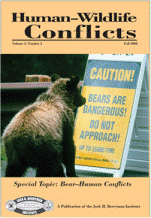Center, Internet, Wildlife Damage Management

Human–Wildlife Interactions
Date of this Version
Spring 2009
Document Type
Article
Abstract
Human–wildlife conflicts associated with suburban white-tailed deer (Odocoileus virginianus) populations have increased in the last 20 years. Primary threats to human health and safety associated with overabundant deer populations include deer–vehicle collisions, attacks on humans, disease, and damage to native and ornamental vegetation. During the fawning seasons (May–June) of 2005 and 2006, 13 confirmed incidences of white-tailed deer attacking humans occurred on the campus of Southern Illinois University–Carbondale. To our knowledge, no report exists that documents free-ranging does attacking humans during the fawning season. The attacks occurred at multiple locations on campus, with injuries to humans, including minor scrapes, bruises, broken bones, and skin lacerations requiring stitches. Wildlife managers may face the increased likelihood of aggressive behavior from deer directed towards humans as deer and human populations increase and come into closer contact with each other.


Comments
Published in Human–Wildlife Conflicts 3(1):129–135, Spring 2009. Published and copyright by Jack H. Berryman Institute http://www.berrymaninstitute.org/journal/index.html